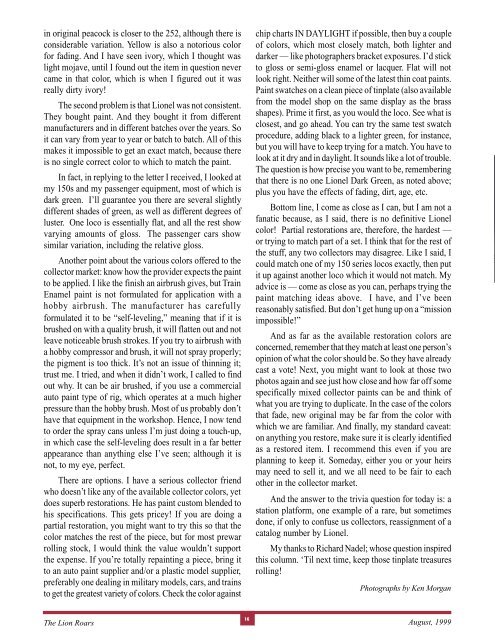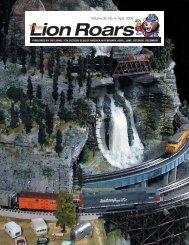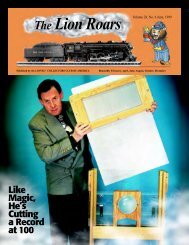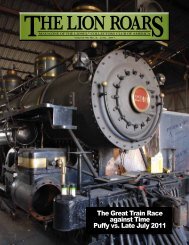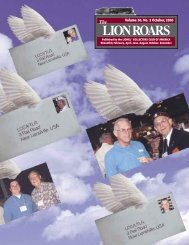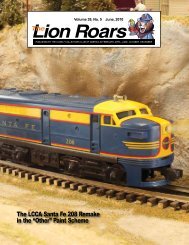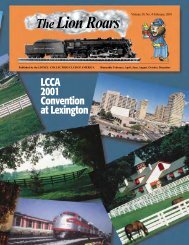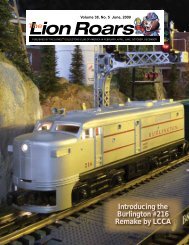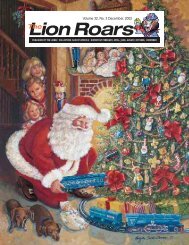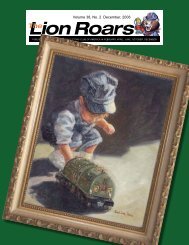The Lion Roars - Lionel Collectors Club of America
The Lion Roars - Lionel Collectors Club of America
The Lion Roars - Lionel Collectors Club of America
You also want an ePaper? Increase the reach of your titles
YUMPU automatically turns print PDFs into web optimized ePapers that Google loves.
in original peacock is closer to the 252, although there isconsiderable variation. Yellow is also a notorious colorfor fading. And I have seen ivory, which I thought waslight mojave, until I found out the item in question nevercame in that color, which is when I figured out it wasreally dirty ivory!<strong>The</strong> second problem is that <strong>Lion</strong>el was not consistent.<strong>The</strong>y bought paint. And they bought it from differentmanufacturers and in different batches over the years. Soit can vary from year to year or batch to batch. All <strong>of</strong> thismakes it impossible to get an exact match, because thereis no single correct color to which to match the paint.In fact, in replying to the letter I received, I looked atmy 150s and my passenger equipment, most <strong>of</strong> which isdark green. I’ll guarantee you there are several slightlydifferent shades <strong>of</strong> green, as well as different degrees <strong>of</strong>luster. One loco is essentially flat, and all the rest showvarying amounts <strong>of</strong> gloss. <strong>The</strong> passenger cars showsimilar variation, including the relative gloss.Another point about the various colors <strong>of</strong>fered to thecollector market: know how the provider expects the paintto be applied. I like the finish an airbrush gives, but TrainEnamel paint is not formulated for application with ahobby airbrush. <strong>The</strong> manufacturer has carefullyformulated it to be “self-leveling,” meaning that if it isbrushed on with a quality brush, it will flatten out and notleave noticeable brush strokes. If you try to airbrush witha hobby compressor and brush, it will not spray properly;the pigment is too thick. It’s not an issue <strong>of</strong> thinning it;trust me. I tried, and when it didn’t work, I called to findout why. It can be air brushed, if you use a commercialauto paint type <strong>of</strong> rig, which operates at a much higherpressure than the hobby brush. Most <strong>of</strong> us probably don’thave that equipment in the workshop. Hence, I now tendto order the spray cans unless I’m just doing a touch-up,in which case the self-leveling does result in a far betterappearance than anything else I’ve seen; although it isnot, to my eye, perfect.<strong>The</strong>re are options. I have a serious collector friendwho doesn’t like any <strong>of</strong> the available collector colors, yetdoes superb restorations. He has paint custom blended tohis specifications. This gets pricey! If you are doing apartial restoration, you might want to try this so that thecolor matches the rest <strong>of</strong> the piece, but for most prewarrolling stock, I would think the value wouldn’t supportthe expense. If you’re totally repainting a piece, bring itto an auto paint supplier and/or a plastic model supplier,preferably one dealing in military models, cars, and trainsto get the greatest variety <strong>of</strong> colors. Check the color againstchip charts IN DAYLIGHT if possible, then buy a couple<strong>of</strong> colors, which most closely match, both lighter anddarker — like photographers bracket exposures. I’d stickto gloss or semi-gloss enamel or lacquer. Flat will notlook right. Neither will some <strong>of</strong> the latest thin coat paints.Paint swatches on a clean piece <strong>of</strong> tinplate (also availablefrom the model shop on the same display as the brassshapes). Prime it first, as you would the loco. See what isclosest, and go ahead. You can try the same test swatchprocedure, adding black to a lighter green, for instance,but you will have to keep trying for a match. You have tolook at it dry and in daylight. It sounds like a lot <strong>of</strong> trouble.<strong>The</strong> question is how precise you want to be, rememberingthat there is no one <strong>Lion</strong>el Dark Green, as noted above;plus you have the effects <strong>of</strong> fading, dirt, age, etc.Bottom line, I come as close as I can, but I am not afanatic because, as I said, there is no definitive <strong>Lion</strong>elcolor! Partial restorations are, therefore, the hardest —or trying to match part <strong>of</strong> a set. I think that for the rest <strong>of</strong>the stuff, any two collectors may disagree. Like I said, Icould match one <strong>of</strong> my 150 series locos exactly, then putit up against another loco which it would not match. Myadvice is — come as close as you can, perhaps trying thepaint matching ideas above. I have, and I’ve beenreasonably satisfied. But don’t get hung up on a “missionimpossible!”And as far as the available restoration colors areconcerned, remember that they match at least one person’sopinion <strong>of</strong> what the color should be. So they have alreadycast a vote! Next, you might want to look at those twophotos again and see just how close and how far <strong>of</strong>f somespecifically mixed collector paints can be and think <strong>of</strong>what you are trying to duplicate. In the case <strong>of</strong> the colorsthat fade, new original may be far from the color withwhich we are familiar. And finally, my standard caveat:on anything you restore, make sure it is clearly identifiedas a restored item. I recommend this even if you areplanning to keep it. Someday, either you or your heirsmay need to sell it, and we all need to be fair to eachother in the collector market.And the answer to the trivia question for today is: astation platform, one example <strong>of</strong> a rare, but sometimesdone, if only to confuse us collectors, reassignment <strong>of</strong> acatalog number by <strong>Lion</strong>el.My thanks to Richard Nadel; whose question inspiredthis column. ‘Til next time, keep those tinplate treasuresrolling!Photographs by Ken Morgan16<strong>The</strong> <strong>Lion</strong> <strong>Roars</strong> August, 1999


